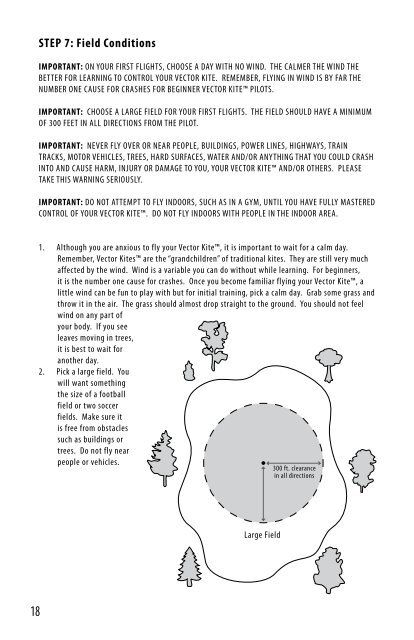Eagle - Premier RC
Eagle - Premier RC
Eagle - Premier RC
Create successful ePaper yourself
Turn your PDF publications into a flip-book with our unique Google optimized e-Paper software.
STEP 7: Field ConditionsIMPORTANT: ON YOUR FIRST FLIGHTS, CHOOSE A DAY WITH NO WIND. THE CALMER THE WIND THEBETTER FOR LEARNING TO CONTROL YOUR VECTOR KITE. REMEMBER, FLYING IN WIND IS BY FAR THENUMBER ONE CAUSE FOR CRASHES FOR BEGINNER VECTOR KITE PILOTS.IMPORTANT: CHOOSE A LARGE FIELD FOR YOUR FIRST FLIGHTS. THE FIELD SHOULD HAVE A MINIMUMOF 300 FEET IN ALL DIRECTIONS FROM THE PILOT.IMPORTANT: NEVER FLY OVER OR NEAR PEOPLE, BUILDINGS, POWER LINES, HIGHWAYS, TRAINTRACKS, MOTOR VEHICLES, TREES, HARD SURFACES, WATER AND/OR ANYTHING THAT YOU COULD CRASHINTO AND CAUSE HARM, INJURY OR DAMAGE TO YOU, YOUR VECTOR KITE AND/OR OTHERS. PLEASETAKE THIS WARNING SERIOUSLY.IMPORTANT: DO NOT ATTEMPT TO FLY INDOORS, SUCH AS IN A GYM, UNTIL YOU HAVE FULLY MASTEREDCONTROL OF YOUR VECTOR KITE. DO NOT FLY INDOORS WITH PEOPLE IN THE INDOOR AREA.1.2.Although you are anxious to fly your Vector Kite, it is important to wait for a calm day.Remember, Vector Kites are the “grandchildren” of traditional kites. They are still very muchaffected by the wind. Wind is a variable you can do without while learning. For beginners,it is the number one cause for crashes. Once you become familiar flying your Vector Kite, alittle wind can be fun to play with but for initial training, pick a calm day. Grab some grass andthrow it in the air. The grass should almost drop straight to the ground. You should not feelwind on any part ofyour body. If you seeleaves moving in trees,it is best to wait foranother day.Pick a large field. Youwill want somethingthe size of a footballfield or two soccerfields. Make sure itis free from obstaclessuch as buildings ortrees. Do not fly nearpeople or vehicles.300 ft. clearancein all directionsSTEP 8: Range TestA range test requires two people. One person is needed to operate the transmitter and the other is tocheck and hold the Vector Kite.1. Hold the transmitter and have the other person walk about 100 steps away from the transmitterwhile holding the Vector Kite. Make sure the person holding the kite has a firm grip on thekite and does not come in contact with the propeller.2. Turn the transmitter on.3. Have the person plug in the battery to the Vector Kite.4. Pull the throttle (left stick) all the way to the backward position. This will arm the throttle.5. Move the steering controls (right stick) and have the other person observe the Vector Kite.Make sure the controls operate smoothly. Use the directions in the “CONTROL TEST” sectionabove to test the Vector Power Unit. Make sure the gimbal moves up and down and from sideto side per the diagrams.6. Signal to the other person you want to test the throttle. SLIGHTLY move the throttle stickforward and determine if the throttle is working properly.7. If all works well, have the person bring the Vector Kite back to you to prepare for launch.8. If controls do not work after the range test, check all connections and batteries. Make sure youare using a fully charged battery for the Vector Kite and that you have fresh batteries in thetransmitter. Make sure the polarities of all the batteries in the transmitter are correct per theinstructions inside the battery hatch.IF MODEL STILL DOES NOT RANGE TEST CORRECTLY, DO NOT FLY YOUR VECTOR KITE. PLEASE CALLTHE PREMIER TOLL FREE CUSTOMER SERVICE NUMBER FOR HELP 1-888-416-0174.CAUTION: THE PERSON HOLDING THE VECTOR KITE SHOULD HAVE A FIRM GRIP ON THE KITE.MAKE SURE PROPELLER IS COMPLETELY CLEAR OF BODY AND HAIR.100 StepsLarge Field18 19









